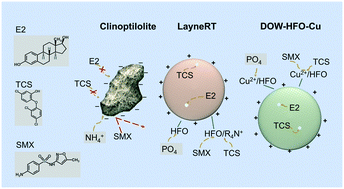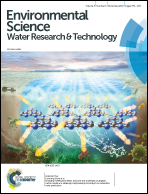Fate and impacts of triclosan, sulfamethoxazole, and 17β-estradiol during nutrient recovery via ion exchange and struvite precipitation†
Abstract
Increasing emphasis on resource recovery from wastewater highlights the importance of capturing valuable products, e.g., nutrients such as nitrogen and phosphorus, while removing contaminants, e.g., organic micropollutants. The objective of this research was to evaluate the fate of the micropollutants triclosan (present as a mixture of neutral and anionic species at neutral pH), 17β-estradiol (neutral at neutral pH), and sulfamethoxazole (anionic at neutral pH) during nutrient recovery using ion exchange-precipitation. Adsorption of the three micropollutants to the phosphate-selective ion exchange resins LayneRT and DOW-HFO-Cu ranged from 54% to 88% in Milli-Q water tests and 50% to 71% in wastewater tests using anaerobic effluent. The micropollutants did not sorb to the ammonium-selective exchanger, clinoptilolite. The presence of the micropollutants reduced the kinetic rates of nutrient exchange onto ion exchangers. However, the micropollutants did not interfere with nutrient capacity on the ion exchangers, likely due to the low concentration of micropollutants and potentially different mechanisms of adsorption (i.e., Coulombic and non-Coulombic attractions for micropollutants) compared to the target ions. Micropollutants that sorbed to the phosphate exchangers were released with phosphate ions during regeneration. Concentrations of NaOH and NaCl in regeneration solutions did not correlate with micropollutant desorption. Among the micropollutants studied, the more hydrophobic triclosan and 17β-estradiol adsorbed to the resins to greater extents. These compounds also demonstrated lower desorption rates than sulfamethoxazole during regeneration in Milli-Q water tests. Batch struvite precipitation tests revealed that the micropollutants were not enmeshed in precipitated struvite crystals nor sorbed during crystallization, indicating that the struvite product was free of triclosan, 17β-estradiol, and sulfamethoxazole.



 Please wait while we load your content...
Please wait while we load your content...